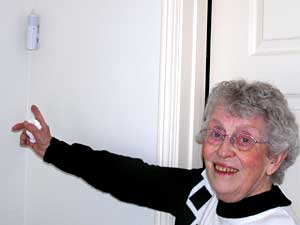|
Audio
Photos
|
 |
| 80-year-old Honor Hacker points to a "Quiet Care" monitor on her apartment wall. (MPR Photo/Lorna Benson) |
Maplewood, Minn. — The device, called "Quiet Care," is really pretty simple.
Inside a small, white plastic tube, about the size of a carrot is a motion-detecting sensor that monitors a senior's movements. That information is then sent to a computer where someone else, usually a relative or a caretaker, tracks the activity.
The device is currently being tested in 17 senior apartments at Lakeview Commons, an assisted living center in Maplewood. Wendy Traffie overseas the project.
"When I come in in the morning the first thing that I do is check in here and sign in," says Traffie. "And as it uploads the information it will give me a clear picture on what has happened in the last 24 hours."
Traffie pages through an activity report on her computer screen. It lists each resident by name and apartment number. The information tracks the number of times there was movement in that senior's bathroom, bedroom, living room, refrigerator and medication box.
Initially Traffie used the information to see if residents spent too much time in one room. That could be a sign the resident had fallen.
But Traffie says it quickly became clear that the information can help identify other problems.
"We'll just pick Wednesday for instance," says Traffie. "So we know by looking at this particular one that there's still a lot of activity going on in the evening and throughout the night when a resident should be sleeping."
Traffie is talking about 80-year-old Honor Hacker. Six months ago Hacker had the monitoring devices installed in her apartment. Recently Traffie noticed that Hacker's reports showed that she was getting up a lot in the night. So Traffie suggested that Hacker visit a doctor to find out if anything was wrong.
Hacker made an appointment with a sleep specialist. A week later she got her results.
"I have apnea," Hacker told Traffie. "It's not a bad case and it's not a little case."
Hacker says she never expected that the monitors could actually helped diagnose a medical problem.
"I didn't see that they'd do any good," says Hacker. "But I just thought well I'll put them on anyway."
Besides Hacker's sleep apnea, Traffie says the monitors detected excessive bathroom use by another resident. Doctors used that information to diagnosis the man's prostate cancer. Traffie says by catching the cancer early, it's likely that the resident will be able to stay in his apartment and avoid intensive nursing home care.
Kathy Bakkenist, a vice president at Ecumen, Lakewood Common's parent company, is also a member of the Center for Aging Services Technology, the organization that's helping coordinate technology demonstrations at the White House Conference on Aging.
"Our goal is really to demonstrate that technology has potential in keeping people independent and in their own homes," Bakkenist says.
Bakkenist says helping seniors stay in their own homes usually is much cheaper than nursing home care. And she says many of the new technologies are designed specifically for home use, including electronic beds that turn on lights when a senior gets up during the night.
Other products help seniors keep active in the community. Bakkenist says her favorite is a new phone for Alzheimer's patients that's equipped with three big buttons, rather than a numeric keypad.
"On the three buttons would be a picture of maybe their two sons and their daughter. And if they're struggling with being lost simply press the picture of the daughter and the phone call goes directly to the daughter who can say, 'Mom, here's where you are. Here's where you need to go,'" says Bakkenist. "And so it's all kinds of technologies like that."
Bakkenist says she hopes to use her time at White House Conference on Aging to convince policy makers to do more to help seniors pay for devices that help them live at home.








